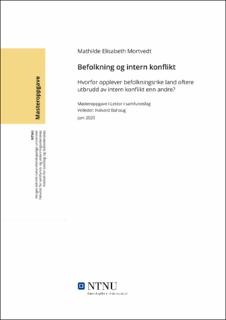| dc.contributor.advisor | Buhaug, Halvard | |
| dc.contributor.author | Mortvedt, Mathilde Elisabeth | |
| dc.date.accessioned | 2021-09-28T17:30:50Z | |
| dc.date.available | 2021-09-28T17:30:50Z | |
| dc.date.issued | 2020 | |
| dc.identifier | no.ntnu:inspera:53627983:14649615 | |
| dc.identifier.uri | https://hdl.handle.net/11250/2784466 | |
| dc.description.abstract | Denne studiens hovedformål har vært å skape en dypere forståelse av hvorfor befolkningsrike land oftere opplever utbrudd av intern konflikt enn andre. Temaet er lite forsket på, selv om sammenhengen mellom konflikt og befolkningsstørrelse viser seg å være ett av få robuste resultater i litteraturen og forskningen. Denne analysen baserer seg på tanken om at det er andre faktorer som har en høy korrelasjon med befolkning som kan være med på å forklare dette forholdet. Fire ulike aspekter har blitt testet: (1) geografisk størrelse og avstand, (2) etnisk mangfold, (3) en større masse å rekruttere fra, og (4) økonomiske insentiver og korrupsjon. Analysen baserer seg på 6 tilhørende hypoteser. Resultatet av de kjørte regresjonsanalysene finner belegg for å anta at både geografisk størrelse, antall etniske relevante grupper og antall etniske ekskluderte grupper er med og påvirker forholdet mellom befolkningsstørrelse og konflikt. Videre viser regresjonsanalysene at det finnes belegg for at både størrelse på rural befolkning og størrelse på BNP påvirker den aktuelle sammenhengen, men her er resultatene noe mer usikre. Antall unge menn viser seg å være vanskelig å bruke som indikator, ettersom denne korrelerer sterkt med befolkningsstørrelse, og gir derfor uklare svar som er vanskelige å tolke. | |
| dc.description.abstract | This paper is written because of the puzzle that connects onsets of civil conflict and population size. The theme for this paper has not been investigated as much as other themes that concerns civil conflict, despite the robust empirical findings in the literature that connects conflict to bigger populations. This analysis is based on the thought that other factors that describe a country and correlate with population can influence the relationship between population and conflict. Four different aspects have been tested: (1) geographical size and distance, (2) ethnic diversity, (3) a bigger mass to recruit from, and (4) financial incentives and corruption. The analysis is based on 6 associated hypotheses. The result of the regression analysis shows that both geographical size, number of ethnic relevant groups and number of ethnic excluded groups has a significant impact on the relationship between civil conflict and population size. The regression analysis also shows that the size of the rural population and the total GDP of the country has an impact on the relationship, but these results are much more uncertain compared to the other factors. It also shows that the variable that measure young men is not an appropriate measure to use with population size, because of the too high correlation between these variables. This makes it hard to say whether the size of young men in a country also affects the relationship between civil conflict and population size. | |
| dc.language | nob | |
| dc.publisher | NTNU | |
| dc.title | Befolkning og intern konflikt | |
| dc.type | Master thesis | |
